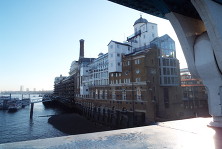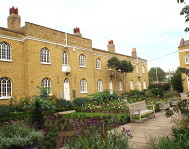








Leathersellers' College
Just to south of the railway viaduct on the east side of Tower Bridge Road is an Edwardian building that incorporates a relief of a coat of arms at roof level which features a roebuck and a ram. This is the coat of arms of the Leathersellers’ Company and serves as a reminder that Bermondsey was once the centre of the leather industry in London. Until 1976, the building was the home of the Leathersellers’ Technical College.
Prior to this College opening in 1909, there was a training institution named the Herold’s Institute Technical School for Tanning in Drummond Road which was backed by the London County Council. “Here courses of lectures are delivered, models exhibited, chemical experiments conducted, and the rationale of all the processes scientifically explained. Students are prepared for the City and Guilds of London examinations, at which many have taken honours and gained medals. The intelligence of the artisan is developed, his emulation excited, and his practical skill increased by scientific training.” (Edward T Clarke, 1902, Bermondsey: Its Historic Memories and Associations)
The Leathersellers’ Company had some connection with Herold’s Institute for in 1894 they gave financial assistance to enable the Borough Polytechnic (forerunner to South Bank University) to run evening courses in Leather Manufacture at Herold’s Institute. At the end of the 19th century, the running of the City Livery Companies came under scrutiny and the Royal Commission investigation indirectly spurred the Leathersellers on to greater involvement in the field of technical education. This resulted in the founding of the Leathersellers’ Technical College in Tower Bridge Road in 1909 and though I have been unable to verify this, I’m guessing Herold’s Institute was incorporated into the new College. The Leathersellers’ Technical College came under the Ministry of Education in 1944.
The College offered both theoretical and practical instruction in handling leather of all descriptions with workshops equipped with the latest machinery for practical work and laboratories for experimental work. It incorporated a dye-house and a tannery and an extensive technical library. Periods of study extended from one to three years.
As the leather trade declined in Bermondsey after the second world war, the decision was taken to close the College in Tower Bridge Road in 1976 and to amalgamate it with the leather department at Nene College, now the University of Northampton. The National Leathersellers’ Centre at Nene College was opened in 1978 with a grant of £500,000 from the Leathersellers’ Company. The building in Tower Bridge Road is now called Osteopathy House and is the headquarter to the General Osteopathy Council.
Web discoveries
- UK Casino Not On Gamstop
- UK Casino Not On Gamstop
- Non Gamstop Casino
- Casinos Not On Gamstop
- Non Gamstop Casinos
- Non Gamstop Casinos
- Non Gamstop Casino
- Casino Sites Not On Gamstop
- Slots Not On Gamstop
- Casinos Not On Gamstop
- UK Betting Sites Not On Gamstop
- UK Casino Not On Gamstop
- Best Non Gamstop Casinos
- Betting Sites
- Non Gamstop Casino Sites UK
- Best Non Gamstop Casinos
- Non Gamstop Casino
- Casinos Not On Gamstop
- Non Gamstop Casino Sites UK